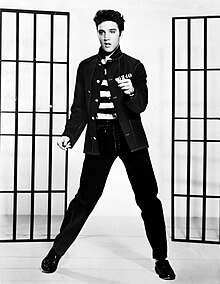Sex symbol

A sex symbol is a person or character widely considered sexually attractive.[2]
History

The term sex symbol was first used between the 1910s and 1920s to describe the first emerging film stars of the era. One of the first sex symbols on-screen was Sessue Hayakawa for men and Asta Nielsen for women. Movie studios have relied heavily on the looks and sex appeal of their actors to be able to attract audiences.[2][3] This concept increased in World War II.[4]
In the 20th century, sex symbols could be male as well as female: actors such as the romantic Sessue Hayakawa and the athletic Douglas Fairbanks were popular in the 1910s and 1920s. Archetypal screen lover Rudolph Valentino's death in 1926 caused mass hysteria among his female fans.[5][6] In Hollywood, many film stars were seen as sex symbols, such as Errol Flynn, Gary Cooper, and Clark Gable. The "bad boy" image of the 1950s was epitomized by sex symbols such as James Dean and Marlon Brando[7] and women like Marilyn Monroe and Jayne Mansfield were seen as the archetype of the blonde bombshell.[8]
While until the 1950s, the sex symbol was just seen as a sexual ideal, in the 1960s it was seen as a symbol of the emancipation of bodies and sexuality with the sexual revolution. [9]
Fictional sex symbols
With regard to fiction, Rotten Tomatoes states that the 1930s cartoon character Betty Boop is "the first and most famous sex symbol on animated screen".[10] Jessica Rabbit (voiced by Kathleen Turner) from the 1988 live-action/animation crossover film Who Framed Roger Rabbit has been described as a sex symbol as well.[11]
Video games have had a few characters that are considered sex symbols; one example would be Lara Croft,[12][13][14] who has had several appearances in mainstream media.
See also
- Blonde bombshell (stereotype)
- Bombshell (sex symbol)
- Sex kitten
- Bimbo
- Himbo
- Pinup girl
- Matinée idol
- Sexual objectification
References
- ^ "BBC World Service – Witness, The Death of Marilyn Monroe". BBC. Retrieved 30 December 2014.
- ^ a b Pam Cook, "The trouble with sex: Diana Dors and the Blonde bombshell phenomenon", In: Bruce Babinigton (ed.), British Stars and Stardom: From Alma Taylor to Sean Connery, pp. 169–171. Quote: "– the sex symbol is usually defined in terms of her excessive sexuality"
- ^ Williams, Gregory Paul (1990). The Story of Hollywood: An Illustrated History. B L Press. ISBN 978-0977629923.
- ^ Flexner, Stuart Berg; Soukhanov, Anne H. (1997). Speaking freely: a guided tour of American English from Plymouth Rock to Silicon Valley. Oxford University Press. p. 373. ISBN 978-0-19-510692-3.
- ^ Hutchinson, Pamela (22 February 2016). "Last of the red-hot myths: what gossip over Rudolph Valentino's sex life says about the silents". The Guardian. Retrieved 12 December 2017.
- ^ "The Queen at 90: The key events of 1926, in pictures". The DailyTelegraph. 21 April 2016. Retrieved 12 December 2017.
- ^ Weinberg, Thomas S.; Newmahr, Staci, eds. (2014). Selves, Symbols, and Sexualities: An Interactionist Anthology: An Interactionist Anthology. Los Angeles: Sage Publications. ISBN 978-1483323893.
- ^ King, S. (2019). Marilyn Monroe and Jayne Mansfield. Blurb. ISBN 978-1388059033.
- ^ Bourget, Jean-Loup (1998). Hollywood, la norme et la marge. Armand Colin. ISBN 978-2200341763.
- ^ "Betty Boop: Boop Oop a Doop". Rottentomatoes.com. Retrieved 30 December 2014.
- ^ "Amanda Knox Is Like Jessica Rabbit". Sky News. 27 September 2011.
- ^ Barboza, David (19 January 1998). "Video World Is Smitten by a Gun-Toting, Tomb-Raiding Sex Symbol". The New York Times.
- ^ "Channel 4 Top 100 Sex Symbols internet poll". Channel4.com. Retrieved 18 May 2012.
- ^ "Boom Raider". Telegraph. London. 24 June 2001. Archived from the original on 24 October 2008. Retrieved 5 March 2008.
Further reading
- Donna Leigh-Kile, Sex Symbols, Random House Inc, Aug 28, 1999, ISBN 188331951X
- 1950s neologisms
- Celebrity fandom
- Sexual attraction
- Sexuality and society
- Sexuality in popular culture
- Symbolism